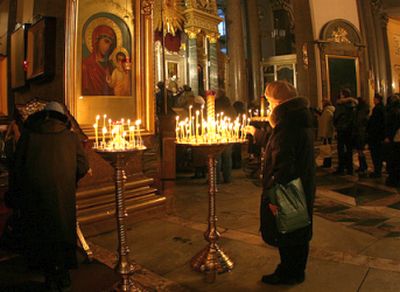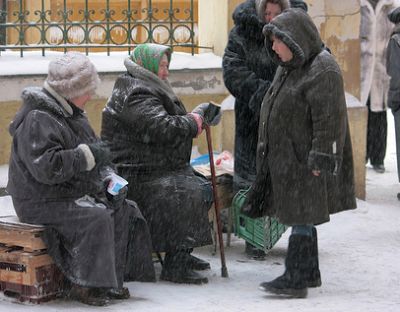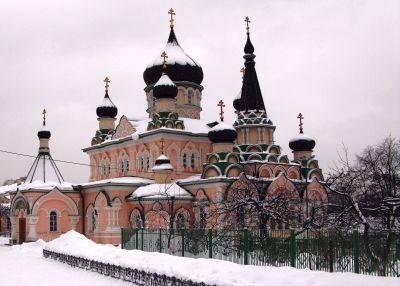Orthodoxy In An Eccentric Land: The Kiev You Didn’t Know
For some, the sight of black ravens circling above — clearly a bad omen — would cause them to leave and never come back. For Jonathan Campion, it inspired him to come back, this time after he learned everything he could about one of Kiev’s most storied cathedrals.
By Jonathan Campion
Ukraine is nobody’s paradise, but nor should it be dismissed as colorless or uninspiring, as many of its visitors do. Northwest of the central part of Kiev there is a district called Lukyanivska, where I lived for a year soon after arriving in the city. From the balcony of my apartment I could see the onion-shaped golden domes of a Russian Orthodox Cathedral in the distance. I never visited it until, returning to my old neighborhood one winter morning, another sight of the domes through a gap in some buildings peaked my curiosity.
Shuffling to and from Lukyanivska’s frosty streets in search of an entrance, I come upon a pink arch at the end of a lane called pereulok Bekhterevsky, beyond which an icy path leads into a small, rectangular courtyard right underneath the cathedral.
To the left of the courtyard as you enter through the arch stands the cathedral, painted the color of pistachio ice cream, with a golden dome on each of its 15 light-blue cupolas. It is so tall that to see its domes from the middle of the courtyard you have to bend your back as well as your neck. The map in the window of the information kiosk in the corner of the courtyard tells me that it is Nikolaevsky Cathedral. Opposite the cathedral — on the right of the courtyard — is the Pokrovsky Monastery. It is a lower, longer building, painted pink and white and decorated with ten dark green cupolas, each with a golden cross on top.
There is an icon of the Virgin Mary above the front entrance. She has seven angels beside her and is holding a white cloth in both hands: the monastery’s name means “Protection of the Virgin,” an important Orthodox festival; pokrov is the Russian word for “shroud.”
Although located in the middle of Kiev, the cathedral’s grounds are calm. They are secluded from the city on the north side by two blocks of apartments, to the east and south by tall trees, and to the west by a ravine. The grounds take up about 400 square feet, with several more icy paths leading away from the courtyard.
 The monastery’s brightly painted walls, and the round and oval patterns in white that decorate its windows and cupolas, are similar to the churches in Russia’s “Golden Ring,” a region that has a historical link to Kiev. The circle of towns in the northwest of Russia — Vladimir, Suzdal, Yaroslavl and Kostroma, with Moscow in its center — were founded by the princes of Kyivska Rus, one of the largest states in Europe between the tenth and thirteenth centuries. Its first ruler, Prince Volodymyr, introduced Orthodox Christianity to Kyivska Rus from the Ottoman Empire in the year 988, before spreading it further east to what is now the Russian Federation. The magnificent interiors of Constantinople’s churches persuaded Volodymyr to adopt the Orthodox faith for his state, as he felt that their decadence prepared worshipers for Heaven.
The monastery’s brightly painted walls, and the round and oval patterns in white that decorate its windows and cupolas, are similar to the churches in Russia’s “Golden Ring,” a region that has a historical link to Kiev. The circle of towns in the northwest of Russia — Vladimir, Suzdal, Yaroslavl and Kostroma, with Moscow in its center — were founded by the princes of Kyivska Rus, one of the largest states in Europe between the tenth and thirteenth centuries. Its first ruler, Prince Volodymyr, introduced Orthodox Christianity to Kyivska Rus from the Ottoman Empire in the year 988, before spreading it further east to what is now the Russian Federation. The magnificent interiors of Constantinople’s churches persuaded Volodymyr to adopt the Orthodox faith for his state, as he felt that their decadence prepared worshipers for Heaven.
The grounds of the monastery are as attractive a sight as I had seen anywhere in Ukraine, but it was an uninspiring day on which to visit. The snow that had fallen during the week had been shoveled into uneven heaps in the courtyard, and the sky was a nondescript light gray. The place was almost deserted, except for a few old ladies, swaddled in thick coats to keep out the cold wind.
As I take my camera from my bag one woman looks up at the sky apprehensively at a group of ravens. In Slavonic folklore black ravens represent the souls of cruel men: Byelorussians and Ukrainians used to believe that these dark spirits set fire to the roofs of farms and dwellings at night, and gathered above the homes of dying sorcerers to take their soul as it left their bodies.
The ravens were circling the domes of Nikolaevsky Cathedral. They attacked each other and cawed noisily, distracting the people below from their rituals. With the country preparing for a presidential election the following week, contested by two nasty characters, the scene seemed to be a metaphor for Ukraine’s present climate. I decided to return the next day with a better understanding of the two buildings. As soon as I got home, I began to research the place’s history.
The monastery, I learned, was founded in 1889 by Grand Duchess Aleksandra Petrovna of Oldenburg. The duchess had moved to Kiev from St. Petersburg in 1881 at the end of her marriage to Grand Duke Nikolai, who was the brother of Russia’s reigning Tsar Aleksandr II. She chose Kiev in order to dedicate her life to the Orthodox Church while healing a crippling injury to her spine in a milder climate.
A kind and generous lady — who had established an orphanage for 5,000 children in St. Petersburg before she left — Aleksandra Petrovna bought two plots of land in Lukyanivska — known then by its Russian name, Lukyanovka — and organized for a monastery, church buildings and a hospital to be built on them. She entrusted their design to the respected architect Vladimir Nikolaev, the man who also crafted the Kiev Cave Monastery. The hospital, completed in 1893, was the largest and most comfortable in the Russian Empire, able to treat, feed and accommodate 500 patients at a time.
Aleksandra Petrovna adopted the church name Anastasiya and lived in a small room in the monastery, spending most of her money on its development. She paid much attention to the hospital, where up to 300 operations took place each year. Anastasiya used her fortune to employ some of the empire’s most skilled surgeons, which ensured that a higher proportion of patients were saved there than anywhere else in Russia during the 1890’s.
Anastasiya spent the last few years of her life planning the creation of the cathedral. It was also designed by the architect Nikolaev and was named in honor of the new Tsar Nikolai II, who witnessed its completion in 1896. Rather than sharing its grounds with the monastery, as I had thought, the cathedral is one of its parts. Anastasiya died at 61 in 1900 and was buried next to the monastery. According to her wishes her grave is marked by a simple wooden cross.
The monastery was shut down by the Soviet authorities in 1925 — by which time the Russian Empire had been overthrown by the Bolshevik revolution, and Kiev had become the capital of the Ukrainian Soviet Republic — but it opened again in 1942 as a war hospital upon the invasion of Ukraine by the German army. It has not closed since. In 1981 a fire destroyed part of the monastery’s territory, after which the cathedral was renovated in secret from Leonid Brezhnev’s Communist government. To this day, the convent’s 300 nuns are responsible for Pokrovsky Monastery’s restoration to its condition of a hundred years ago. They are helped by the Kiev city council, which has paid 20 million hryvnya ($2.3 million) to replace the property stolen by the Communist party after the cathedral’s closure.
* * *
Six inches of snow fell on Kiev overnight. It stuck to the city’s trees like icing sugar on a whisk, and as I walked into the courtyard the next morning through the pink arch, the white powder crunched softly under my boots. Patches of it had settled on the top of the monastery and the cathedral’s domes. The temperature had fallen to -12 degrees: cold enough to keep the ravens in their nests or to bring them to the ground.
There were more visitors to the grounds than had been the day before. There were couples in the courtyard, holding the hands of toddlers in brightly-colored one-piece snow suits, their cheeks made red by the bitter wind. Half a dozen middle-aged workmen in army fatigues were scooping snow from the steps that lead to the entrance to the cathedral.
 Several old ladies were walking slowly around the monastery, pausing at the entrance to cross themselves in front of the icon of the Virgin Mary, the prayers to which Anastasiya felt healed her spine. These women — endearingly known as babushki (grandmothers) — hobble through Kiev alone. Many do not have a family who can support them and starve on meager pensions. They beg next to supermarkets and metro stations, the kopecks given to them sometimes covering the bottom of the plastic cups in their wrinkled hands. We should sympathize, yet each woman’s cantankerous eyes convince us that she is as tough as the boots on her feet. Seeing these babushki pray for health put their vulnerability into context.
Several old ladies were walking slowly around the monastery, pausing at the entrance to cross themselves in front of the icon of the Virgin Mary, the prayers to which Anastasiya felt healed her spine. These women — endearingly known as babushki (grandmothers) — hobble through Kiev alone. Many do not have a family who can support them and starve on meager pensions. They beg next to supermarkets and metro stations, the kopecks given to them sometimes covering the bottom of the plastic cups in their wrinkled hands. We should sympathize, yet each woman’s cantankerous eyes convince us that she is as tough as the boots on her feet. Seeing these babushki pray for health put their vulnerability into context.
A group of nuns pass me on the courtyard. The youngest was perhaps in her mid-twenties; the oldest not much more than 50. They were all dressed in black robes and each wore a black platok (headscarf). Orthodox women may not enter places of worship without something to cover their hair — men, on the other hand, must remove their hats. The nuns smile and speak in cheerful tones, referring to their senior colleague as Matushka (Mother). Beside the monastery, in an allotment fenced off from the paths, is a cemetery with the graves of three of the heads of the monastery laid in an even row. Beside each grave, stubby peach-colored candles shimmer softly from inside glass boxes. The names of the Matushki are written on their headstones in archaic Cyrillic lettering. Anastasiya’s is the most basic.
A path near to the information kiosk leads me to a garden behind the cathedral where the snow is pure and deep. With no noise carrying to this corner of the grounds, the garden is incredibly peaceful. I am alone in it until a red squirrel dashes in front of me and climbs up to the top branches of a tree; in another tree a woodpecker was building a nest. A dozen sparrows disperse when a cat from one of the nearby houses climbs over the fence and struts across a pile of logs. There are footprints in the snow on the steps at the cathedral’s side entrance, but the door is locked. Unable to go inside, I had seen everything that I could.
Moments after leaving the courtyard through the pink arch, the pious murmur of the monastery is replaced by the urban hum of vulytsya Artema. There are still two hours before I have to be anywhere, enough time to find somewhere to write about my morning and look through my photographs.
I walk past the Kyivska Rus cinema and through an underground passageway. Then I squeeze through Lukyanivska’s food market, its rows full of people, its traders noisily hawking dozens of sorts of spices, apples, vegetables and fresh meats. Outside Lukyanivska metro station I buy a notepad and a blue biro from a kiosk and retrace my steps until I arrive at Shokoladnitsa, one of a chain of Russian cafés a few hundred paces from the arch.
The stereo in the café plays Celtic folk music while I drink my first hot chocolate, then Dutch techno as I sip my second. The scribbles in my notepad could describe a different land, so does the atmosphere differ from that of the monastery. While Lukyanivska has risen and fallen with the Tsars, war, Communism and independence in the last century and a quarter, the land plot on Bekhterevsky lane keeps on the same course that Aleksandra Petrovna planned for it. Modern Ukrainians may now turn to Shokoladnitsa instead for comfort and refreshment, but the monastery represents their nation’s resilient soul.


